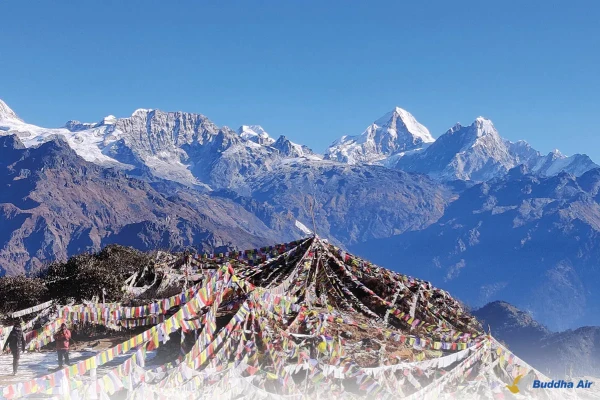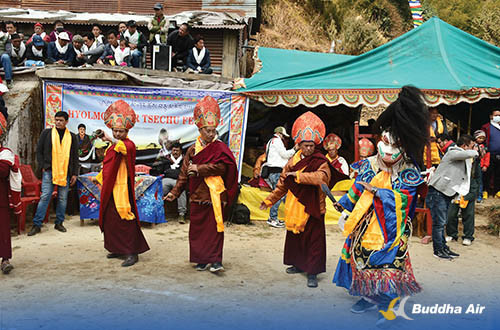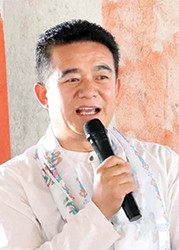Complete Guide on Ama Yangri Trek and Tips for Trekkers

Ama Yangri (3,775 meters) is located in Sindhupalchowk district. The hill is revered as a goddess who fulfills the wishes of the devotees. In the local language, "Ama" means protector, and "Yangri" means fulfiller of wishes.
On the hill of Helambu Rural Municipality-1 and Paachpokhari Thangpal Rural Municipality-2, there is no permanent settlement except a four-story monastery. Inside the monastery stands a statue of Guru Rinpoche (Padmasambhava), the Buddhist master who meditated in Helambu. Helambu is considered a "bayul"—a hidden paradise designated by Padmasambhava for yoga, meditation, and spiritual practice.
Ama Yangri lies within Langtang National Park, a region rich in natural beauty. From here, you can see the majestic Himalayan ranges, including Gaurishankar, Dorje Lakpa, Jugal, Langtang, Ganesh, and other snow-capped peaks.
The view is especially breathtaking in winter. Looking down from the hill, a sea of clouds unfolds beneath you. The sight of sunrise and sunset is mesmerizing, offering a feeling of vast openness. Reaching the hilltop rejuvenates both body and mind, filling you with renewed energy.
Long ago, Tarkeghyang village was situated on the hill of Ama Yangri. However, due to the rocky terrain, the settlement was relocated. To this day, villagers return annually to worship, and a grand festival is held in Chaitra-Baishakh with great enthusiasm.
Ama Yangri is accessible year-round. In Chaitra-Baishakh, Helambu appears all red, covered by Red Rhododendrons, while in Poush-Magh, it remains covered with snow. During the monsoon, marigolds bloom abundantly, creating a golden landscape. In Asoj-Kartik, the clear skies offer stunning views of the Himalayas. 
Ama Yangri is regarded as the guardian deity of Helambu residents. Helambu is the name of a region, now governed under Helambu Rural Municipality, which was formed by merging five former VDCs: Mahankal, Ichok, Palchok, Kiul, and Helambu. The municipality covers an area of 287.26 square kilometers.
Parts of Helambu fall within Langtang National Park. Some of its most famous places include Tarkeghyang, Melamchighyang, Shermathang, Kakani, Ama Yangri, Kutumsang, Milarepa Cave, Ghopteghangyang, Chitre Danda, and Guru Rinpoche Danda.
Helambu is a sacred land, home to caves and footprints where Padmasambhava and the Buddhist yogi Milarepa meditated. It houses ancient monasteries, prayer wheels (manes), and stupas (chaityas). The region is inhabited by diverse ethnic groups, including Hyolmo, Sherpa, Tamang, Bahun, and Dalit communities.
Helambu trekking is a favorite among foreign tourists and is now gaining popularity among domestic travelers. A full trek through Helambu can last up to a week, but those traveling from Kathmandu need only two days to reach Ama Yangri and return.
Other must-visit places in Helambu include Tarkeghyang, Melamchighyang, Shermathang, and Guru Rinpoche Danda!
Tour Package
Chomothang Resort at Ama Yangri Base Camp offers tourists a one-night, two-day tour package. The package is priced at Rs. 8,000 and includes a jeep ride from Kathmandu to Chomothang, dinner, accommodation, and breakfast.
Contact: Dawa Sherpa – 9851314318
How to Reach Ama Yangri
Public buses operate from Jorpati, Kathmandu, to Tarkeghyang (2,550 meters) via Melamchi, covering an 85-kilometer distance. Jeeps can reach Ama Yangri Base Camp at Chomothang (3,200 meters). From Chomothang, a 2.5-kilometer climb leads to Ama Yangri, taking about three hours. For those trekking, it takes approximately three hours to reach the base camp from Tarkeghyang via a 6-kilometer motorable road. It is recommended that you stay overnight at Chomothang and begin the three-hour ascent to Ama Yangri early in the morning.
6 Essential Tips for Trekkers
- Gather information about the weather, road conditions, and accommodation options—book hotels in advance, especially during peak trekking seasons.
- Carry a light rucksack with essentials like a jacket, T-shirt, cap, sunglasses, gloves, socks, walking stick, water bottle, thermos, flashlight, camera, diary, pen, towel, toothpaste, soap, and a first-aid kit.
- Choose sturdy trekking shoes. Avoid walking uphill with your mouth open—it makes your throat soar. Walk at a steady pace and be mindful of your knees when descending.
- Above 2,500 meters, oxygen levels drop, which may cause breathing difficulties. Take breaks and drink plenty of water while ascending. If you feel dizzy, exhausted, or nauseous, rest immediately or descend.
- Drink plenty of soup and warm water. Avoid greasy, spicy, and sour foods, which can cause acidity and headaches. Refrain from alcohol and smoking, as they make trekking more difficult.
- Be mindful of the villagers' traditions and lifestyles. Ask for permission before taking photos of religious sites or locals. Enter monasteries or temples only with permission and follow local customs.
 "We are working to improve the road to Ama Yangri's base camp in Chomothang so that motorbikes, scooters, jeeps, and other vehicles can travel more easily. Currently, most domestic tourists visit Ama Yangri and return the same day. I encourage visitors to explore the surrounding cultural and natural heritage sites, such as Milarepa Cave, Melamchi Water Spring, and the Helambu Great Trail."
"We are working to improve the road to Ama Yangri's base camp in Chomothang so that motorbikes, scooters, jeeps, and other vehicles can travel more easily. Currently, most domestic tourists visit Ama Yangri and return the same day. I encourage visitors to explore the surrounding cultural and natural heritage sites, such as Milarepa Cave, Melamchi Water Spring, and the Helambu Great Trail."
Nima Gyalzen Hyolmo
Chairman
Helambu Rural Municipality
